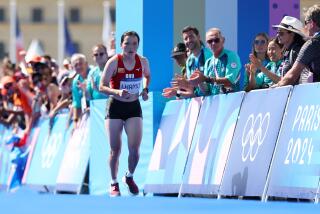Can’t Run a Marathon Without a Program
- Share via
SAN DIEGO — Jeff Galloway, a salesman of sorts, is not exactly peddling a product everyone wants or needs. In fact, we’re talking a very tough sell.
It might, indeed, be easier to sell rattlesnakes door-to-door than to get folks to buy what Galloway is selling.
His problem is complicated by the fact that his “product” is not tangible, unless maybe you are talking pain. You can’t hold it in your hands, but you can certainly feel it in your legs and lungs.
What he’s selling is a notion.
You, yes you sitting there in your recliner with a can of beer and a basket of potato chips, can complete a marathon.
Huh?
In (or on) what? A taxi? A trolley? A hearse? Or a horse?
A marathon is 26 miles and change. The change is no big deal. Not to worry how many yards are left after running 26 miles. It would be like paying $50,000 for a car and then worrying about the sales tax.
Galloway came to San Diego from his Atlanta home, courtesy of sponsorship by Olive Gardens Restaurants, to encourage interest in the San Diego Marathon. The race isn’t until Jan. 24, 1993, but that’s the point. He’s looking for participants, not spectators.
Marathons don’t cost much to enter, but a price must be paid nevertheless. The cost comes in the form of miles of preparation. And this price must be paid on an installment plan.
That’s where Galloway comes in. He has an “installment plan” for banking those miles.
“We’re not trying to qualify people for Boston,” he said. “We’re just trying to set up a program to help people prepare to get through a marathon.”
The idea, as I understand it, is not to get a jump on preparation for the 1996 Olympics, but to able to cover the marathon distance without packing a lunch or sleeping bag. It apparently doesn’t have to be an all-day or overnight journey.
Galloway, 47, a 1972 Olympian in the 10,000 meters, has had a bit of marathon experience, like 80 of them.
“My first 60,” he said, “were blood and guts efforts. The best ones are when you get to the finish line and you don’t have anything left. The last 20 have been recreational marathons, maybe at an eight-minute pace or slower.”
To a guy who has run in the Olympics and has a marathon best of 2:16, an eight-minute pace is like a Sunday stroll in a park. It is not part of his vision, or his program, that anyone preparing now will maintain even Galloway’s version of a recreation pace by Jan. 24.
Working with In Motion, the marathon’s producer, Galloway has set up a game plan for preparation.
“We’ll divide into pace groups so everyone can run with people of their own ability,” he said. “The group leader will be like a Marine D.I., only just the opposite. His job will be to hold people back. Everyone will take walking breaks, even veteran runners, and bare beginners will start out walking one minute every two or three minutes.”
Should you have maniacal friends who run every day, as I do, understand that Galloway encourages no such insanity. What’s more, he allows himself to run only on alternate days.
Folks in his program will not run that often.
“The time commitment is what scares most people off,” he said. “Our program is minimal. We have people do a long run every other weekend and two half-hour runs on their own during the week.”
Even the long runs, he said, start out relatively short, but they do build up to 20, 23 and, ultimately, 26 miles in the last couple of months before the marathon itself.
“Actually,” he said, “once the run gets to 20 miles, we space them three weeks apart . . . 20, then 23, then 26 three weeks before the marathon itself. Then we back off to long runs of maybe 10 to 12 miles.”
Amazingly, a lot of folks do this sort of thing.
“The first wave,” Galloway said, “was in the late 70s or early 80s. These were mostly people in their 20s, doing a 10K every weekend and a marathon a month. The new wave of runners are in their 40s and 50s, folks who maybe stated with walking or aerobics and yearned for a challenge. The first wave was 75% men and the new group is 50% women.”
But why, Jeff, why run 26 miles when a sensible little 5K or 10K is every bit as healthy . . . and maybe more so?
He laughed. It was a sensible little question, he conceded.
“The reason I see,” he said, “is that the marathon is Mt. Everest to a lot of people, but it’s Mt. Everest in their backyards. It’s a challenge that gets your attention. You can slough off and still get through a 10K or a 5K. The marathon commands your attention.”
He leaned forward.
“To the common man,” he said, “the marathon is the Olympics.”
You finish, you win.
More to Read
Go beyond the scoreboard
Get the latest on L.A.'s teams in the daily Sports Report newsletter.
You may occasionally receive promotional content from the Los Angeles Times.






